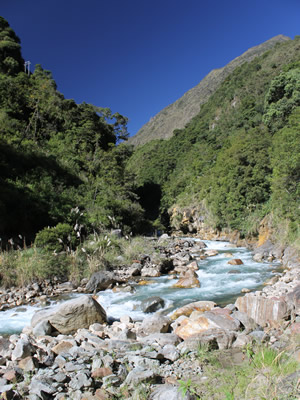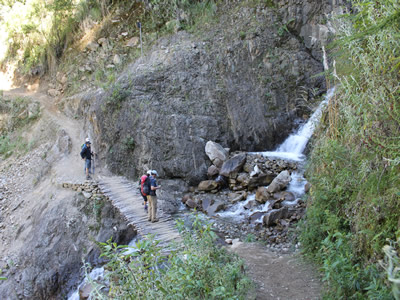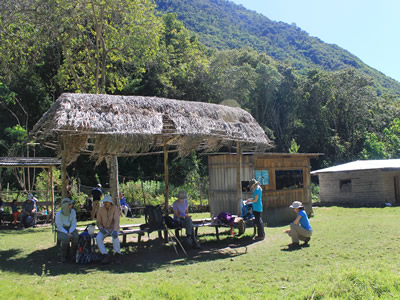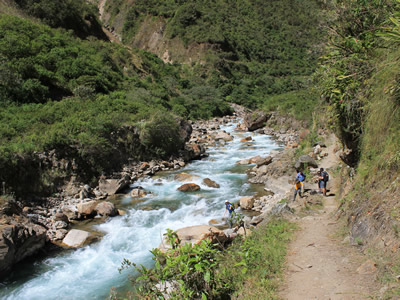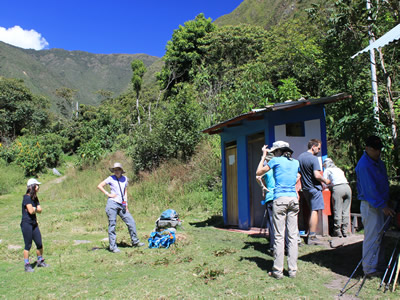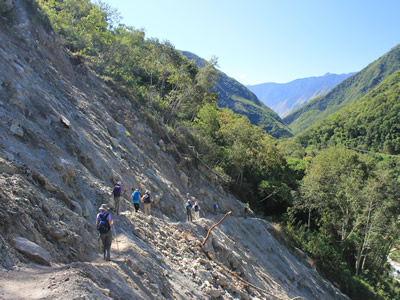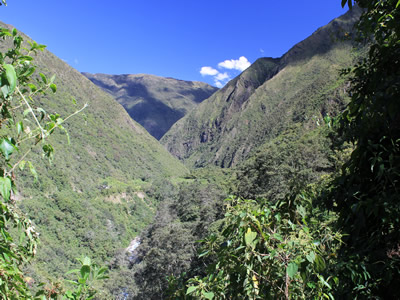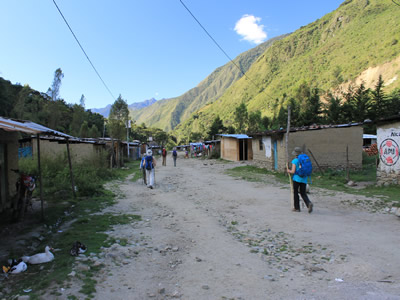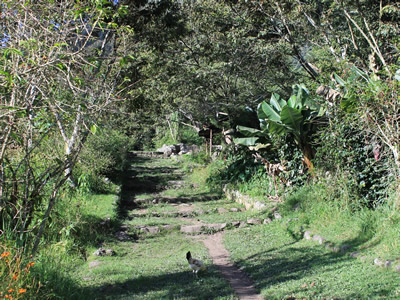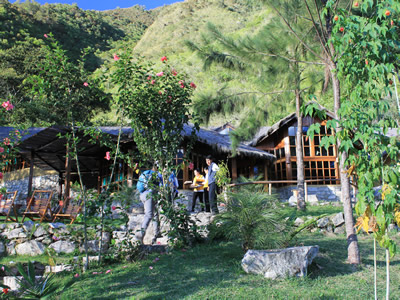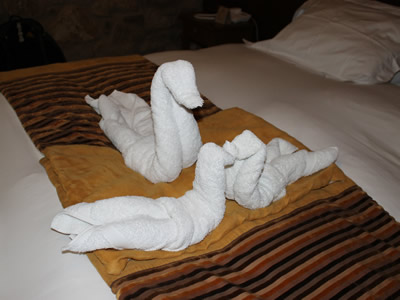Peru - It Ain't Over Till It's Over
Staying at the Colpa Lodge we thought that the toughest part of the trek was done and we had an easy finish ahead of us. The high altitude part was over and we were descending every day. We should get stronger each day as we got lower and there was more air to breathe. The weather was warmer and the threat of bad weather less worrisome. There were only two days of hiking to go.
Our early arrival at the lodge gave us some extra time to get organized for the last section. We found out that they did laundry at the lodge so Sandy and I got a load together. Because of the strict weight limits we were expecting to have to do some laundry in the bathroom sink but now we didn't even have to worry about that. We should easily be set now till the end of the trek when we returned to Cusco and got the clothes stashed in our extra bags in storage.
The only worry that I had for the last part of the trip was insect bites. I have to admit that as much as I love to hike, I hate hiking when it is buggy. On the trek so far, high above timberline where it got freezing cold at night, there wasn't much to worry about. Now we were lower, it was warmer and the vegetation was lush. It was perfect habitat for insects. From reading accounts on the internet before we left by people who had done the trip, many of them mentioned mosquitoes but the real problem was sand flies.
Sand flies are nasty. We had encountered them on a dive trip that we took to Honduras. Although the beaches there were beautiful, we spent all our time indoors when we weren't diving to escape the sand flies. The bites that I got swelled up and itched for a month. It wasn't a good memory.
Our other experience with sand flies was in New Zealand, where they are notorious among hikers and just about everyone else too. On our trips there, especially while we were on the Milford Track, they were a problem. The only good thing about the Kiwi variety is that they never bother you if you are moving. So while you are hiking they aren't a problem. Just don't ever expect to stop to rest.
I was worried about mosquitoes and, given what I had read and our past experiences, was even more worried about sand flies on this trip. I had even brought our bug net helmets along just in case things were really bad, even though space and weight were tight. The good news was that I hadn't noticed many insects today when we descended into the forest from Wayra Lodge so hopefully they wouldn't get too bad. I got a couple of mosquito bites on my arms but that always happens when you hike. I did have some minor itching on my lower back since our snack stop. I thought that was strange. I wondered what it was.
When I took my shower at the end of the day it turned out that the sand flies had gotten to me. One or more must have gotten under my tshirt, probably while we were stopped at the Inca wall. I had ten bites on my lower back scattered over my kidneys. Those sand flies must have had a real party. By now the bites were dark red and each one was swollen to the size of a quarter. And they were really beginning to itch. Sandy was impressed and told me to wait before getting dressed so she could take a picture. I didn't listen to her so all of you can thank me for not having to see those photos in this post.
Now I was really worried about the bugs. The lower we went the heavier the jungle would be, the warmer and more humid the weather would be, the worse the bugs would get. With two more days left on the trail I didn't want to look forward to another twenty plus sand fly bites. I'd end up having to wear a straight jacket to keep from scratching myself to death.
Ok, I'll just jump ahead to the end. The last two days weren't that bad. Yes, I got some more bug bites but there were no swarms of insects on the rest of the trip. The mass of bites I got on the first day was a fluke. And this time the damn sand fly bites didn't last for an entire month.
Something else came up though which made the last part of the trip more challenging for everyone. But before I get into that I realize that I haven't really talked about the others in our trekking group. So I will take a brief interlude to introduce my fellow hikers.
There were twelve paying customers on the trip, five married couples and a mother-daughter combination. Two of the couples were from the Bay Area in California, Blair and Carie, and Tim and Kelly. They were probably the youngest in the group and were the only ones with kids at home. Mike and Gayla were from Virginia, in the Washington DC area. They both had done a lot of dive travel trips but not many hiking trips. Derek and Tamara were from Seattle. They were probably the most experienced hikers besides us. Mary and Suzanne were mother and daughter from Naperville, Illinois. I thought that there was a good chance that I would be the oldest member of the group but it turned out that Mary had me beat. She was seventy one and a very strong hiker. But hey, at sixty I was the second oldest.
Our whole group had done very well so far. Everyone was doing the hikes. Mike had a little trouble with some of the steep downhills because of bad knees but he was a soldier and toughed it out. No one had problems with altitude sickness. And unlike the group that was behind us that we had seen at Salkantay Lodge, we hadn't had much trouble with people getting sick. Tim had stomach problems the very first day so he and his wife Kelly skipped the Humantay Lake hike, but he recovered the next day and had been going strong since then. Illness wasn't a problem for us - never a sure thing in a third world country. We had all been careful watching what we ate, always washing our hands, only drinking purified water. So far we had been lucky.
Until now. Blake didn't turn up for the fancy panchamanca lunch or dinner. Carie said he was sick and just wanted to sleep. It turned out that he was ok the next morning and was ready to go again. But it was just the beginning.
Next we had problems. Sandy woke up early with stomach troubles. That was not good. Although we were going down hill, we had a long hike, over ten miles, with a climb up to the lodge at the very end again. She skipped breakfast - she didn't feel like eating and diarrhea is always a concern on the trail when you have GI problems. Although she was nervous and didn't feel strong she was ready to give it a try.
The first section of trail was tough. We had to cross the gorge to get back to the side of the river with the main trail. We didn't want to backtrack, the day was going to be long enough as it was, but the descending trail further downstream was really steep. In spots where it was wet and muddy it was extremely slippery. I had to hold on to tree branches beside the trail to keep from falling down. I was expecting someone to slip. But after a tough half hour we made it down to the river and crossed a bridge. Now we were on a wide trail following the river and the going was easy.
But it was long. We spent most of the morning following the Rio Santa Theresa. We were no longer in the high mountains. Now we were in the cloud forest. We were on the east slope of the Andes, between the high cold peaks and the hot and humid Amazon basin. At certain times of the year the forest is in perpetual fog, day after day. Often the clouds sit right at the level of the forest canopy. There are cloud forests in many parts of the world but they are most commonly found in this part of South America. They are known for incredible biodiversity and are very beautiful as well. Sadly they are strongly affected by climate change. Many of the species which live there will likely become extinct over the next few decades. The cloud forest in Peru could even be totally wiped out by 2100 according to some experts. It's very sad because it's so predictable.
At one point we came to a clearing with a farmhouse. The locals had taken advantage of all the trekkers coming this way and built a shed to be a snack stand. I was happy to help the local economy and bought a Diet Coke and a candy bar. They had a large table set up with shade from the sun. They even had a toilet nearby that you could use for a few soles. A nice spot for our midmorning break. It was always interesting to see how fast local people respond to the economic opportunity presented by lots of international tourists. Here we were miles from the road in the jungle of Peru at a minimart.
A little girl from the farm spent the time checking us out. When Suzanne set her phone down she quickly picked it up and in about thirty seconds found a game on it and was playing. She had obviously had exposure to high tech even in this remote area. Even the dogs from the farm were hanging around us, playing and trying to get a handout.
Around noon we reached another similar upgraded farm where we stopped for lunch. They served a quinoa salad that everyone seemed to love although I didn't care for it. Quinoa originated in this part of the Andes and is still very popular here so we saw a lot of it at meals. I don't eat much while hiking so I just skipped the main course. Cari didn't eat much either because she said that she wasn't feeling well. After lunch we had a long rest and then it was back on the trail.
The afternoon hike was similar to the morning. We continued to hike down the valley of the Rio Santa Theresa. The river was usually several hundred feet below us on our right. It was quite warm but not oppressively hot. Much of the time we were shaded by the vegetation which was nice. Sandy and I were near the front where Jairo was leading. He had a radio to keep in touch with Juan who was at the back of the group, which was pretty spread out. Unlike the high country where we could see a long way, here in the forest we couldn't see very far along the trail. Jairo and Juan were carrying radios to keep in touch and at one point Jairo got a call. There was a delay at the back of the group. Cari really wasn't feeling well. After a while we learned that she couldn't hike anymore and had gotten on the horse. Having a horse along just in case had paid off since there was no easy way to get to our destination for the night if someone couldn't continue on their own.
There were a lot of side streams coming down to the main river. Because the valley was so steep sometimes they were impressive waterfalls. At one point we rounded a bend and saw a huge scar where a section of the slope ahead had washed out recently. The forest, and the trail, were just gone. There was only an open slope going down several hundred feet to the river. Fortunately some time had passed since it happened and other parties had already crossed the obstacle. There was a tread in the soft dirt left by the landslide that we were able to follow. It looked pretty scary as we approached but once we were on it, it turned out to be ok. But we did stop at the far end to wait for the others who were some distance behind. I didn't envy Cari when she had to ride the horse across that section but she made it across ok. It was clear that she was feeling really sick.
The hiking was straightforward after that but we still had a long way to go. Finally we reached the town of La Playa. The village was reached by a road. It was a long, windy, rough, dirt road. But it was still a road. It was either the end of the road, if you were riding, or the beginning of it, if you were a trekker. It all depends on your perspective. But either way we were no longer in the backcountry. Now we would ride for the next segment.
Soon. Some time ago a flood had wiped out the bridge across the river that runs through town and it had never been repaired. Now we had to walk all the way to the other side of the town, which was the furthest point vehicles could reach. We hiked down the main street. There were people working, kids playing and dogs and chickens running around loose. I didn't see any guinea pigs. I have to admit that the town didn't look very appealing. It was dusty and dirty. Most of the houses were just shacks. The people here were obviously poor.
Finally we reached the real road. There was a small bus terminal there, a bar/restaurant, and a campground for trekkers. Even though we were tired I think we were all glad that we weren't staying here. There was a large van waiting for us. I didn't think we would all fit but twelve of us, our packs, and the driver all managed to get in the van. It sure was cozy though. Fortunately we only had to drive for about fifteen minutes to reach our drop off point. I guess we could have walked but we were all tired at that point. Walking the road would have been unpleasant because of the dust and dangerous because of the traffic. So there were no protests from any of us about riding. Cari especially seemed completely miserable at this point and really out of it.
The van dropped us off where a section of old Inca trail left the road and angled up the hillside. It was in remarkably good shape and made for easy walking. It wasn't far to the lodge, a little over a mile and five hundred feet of elevation gain, but a climb like that is never fun at the end of a long day. Most of us started up although the Californians hung back with Cari. She was really having trouble getting started. The horse was back in La Playa so she had to walk the last bit.
I plodded up the last section until finally we were at the lodge. I had to admit that I was tired. Sandy had been really tough on this hike considering that she had been ill at the start. She did a difficult hike even though she wasn't feeling good.
We found out later that Cari almost didn't make it up to the lodge. She could barely walk and kept asking if there was any other way. But there was no option to ride to the lodge and nowhere else to go. Fortunately she was really small and her husband Blair was a big guy. He actually carried her piggy back most of the way up. That night he was given the official Good Husband Award by a unanimous vote of the group. Cari just crashed as soon as she got to the lodge and we didn't see her at all that evening. Fortunately the next day she was feeling better.
It had been a tough day. Several other members of the group now were feeling sick, including me. And we still had one more day of hiking to go. It's ain't over till it's over.
